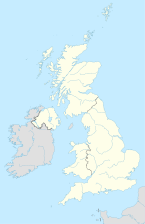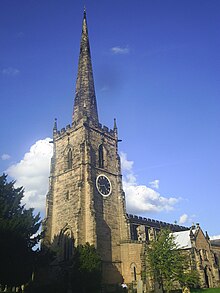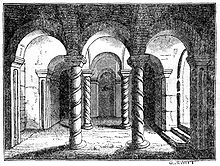Repton (Derbyshire)
| coat of arms | map | |
|---|---|---|
 Coat of arms is missing |
|
|
| Basic data | ||
| District : | South Derbyshire | |
| Geographic location : | 52 ° 50 ′ N , 1 ° 33 ′ W | |
| Height : | 55 m ASL | |
| Area : | 47.17 km² (ward) | |
| Residents : | 2,707 | |
| Population density : | 57.39 inhabitants / km² (ward) | |
Repton is a parish (parish) and an administrative district (ward) in the south of the English county of Derbyshire in the District of South Derbyshire . The place Repton lies on the southern edge of the floodplain of the river Trent . The 2001 census found 2707 residents for the parish and 4635 for the Repton County.
history
In the early Middle Ages, Repton was the traditional burial place of the kings of Mercia , one of the Anglo-Saxon empires . In 653, Repton was the starting point for the Christianization of the Midlands . After Mercia was Christianized under King Peada , a double monastery was set up in Repton under an abbess. The center of the village is dominated by the church of St. Wystan (also St. Wigstan). The crypt under the church was built in the 8th century and served as the tomb of the royal family. The following members of the royal family are buried here:
The remains of the Mercian king Wigstans were buried in the church after his assassination in 840 in 849 and various miracles were soon ascribed to him. This made Repton a place of pilgrimage. Wigstan was later canonized and the second namesake of the church. Repton was the original bishopric of the Midlands after Christianization until the seat was moved to Lichfield in 669 .
In 873/74 the Great Army , a Danish Viking army that had been plundering England since 865/66, wintered in Repton. Excavations that were carried out between 1974 and 1988 brought the remains of this camp to light. The army had built a D-shaped wall with the involvement of the church. The doors of the church served as a fortified gateway. The steep bank of the Trent protected the north side of the camp. A Saxon burial chapel west of the church was leveled by the members of the army and at least 249 people were buried in its place, including one person of high rank.
Repton School
In the buildings of a priory founded in 1172, an independent public school was founded in 1557 after the secularization of the English monasteries under Henry VIII (King 1509–1547) . Well-known graduates of the Repton School are:
- Basil Rathbone (1892–1967), British-American actor
- Harold Abrahams (1899–1978), Olympic champion in the 100-meter run in 1924
- Arthur Michael Ramsey (1904–1988), Archbishop of Canterbury from 1961 to 1974
- Eric Maschwitz (1901–1969), entertainer, lyricist, author and television producer
- Edward Upward (1903-2009), writer
- Douglas Cooper (1911–1984), collector, curator and art historian
- Denton Welch (1915–1948), writer and painter
- Roald Dahl (1916–1990), writer
- Adrian Newey (* 1958), Technical Director of the Formula 1 team Red Bull Racing
- Jeremy Clarkson (* 1960), presenter, author and journalist
Known residents
- Guthlac (673–714), hermit, monk in the monastery of Repton and patron saint of archaeologists
- Edward Upward (1903-2009), writer
Daughters and sons of the city
- Jane Welch (* 1964), fantasy author
- Robin Sharman (* 1979), cyclist
Web links
- Repton Village website (English)
- Repton Parish Council (English)
- Repton School (English)



